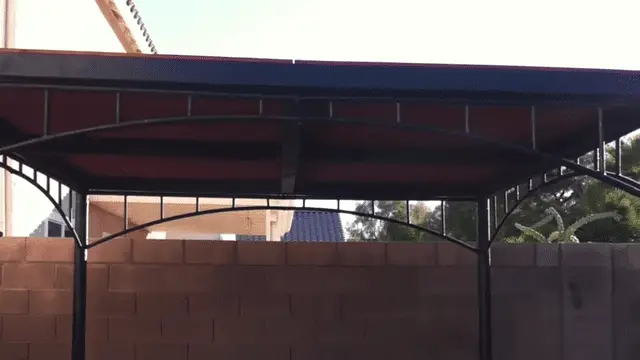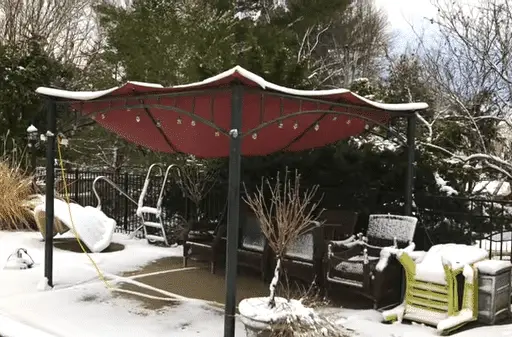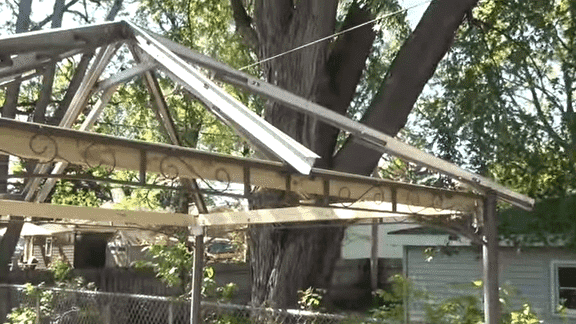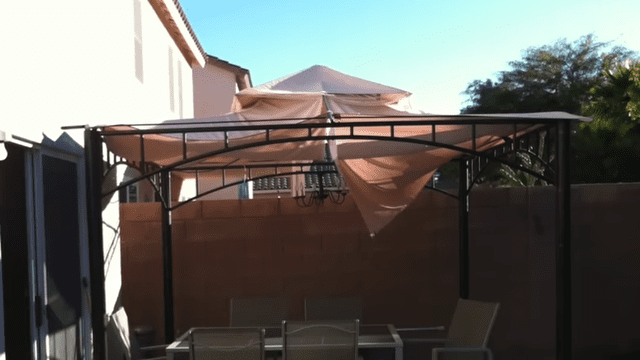A gazebo is a nice thing to have in your backyard. It gives you a shady place to rest on a hot day and can make your outdoor evenings more romantic. But if the top part of the gazebo gets ripped, it won’t look good and can let in rain and sun. This will make it less comfortable to use. There are some things you can do to stop the gazebo canopy from ripping.
Make sure the top part of the gazebo is fixed tightly to the frame so it won’t move around. Use a canopy made from strong materials that will last a long time. Be gentle when you open and close the top part so you don’t accidentally cut it with sharp things.
You Do Keep A Gazebo Canopy From Tearing: Take a can of waterproof spray and use it to cover the whole top part of the gazebo. Hold the can about 8 inches away from the material and spray at an angle to make sure you cover it well.
It’s better to apply two coats so that the top part of the gazebo is fully protected. Let it dry, then do the same thing to the other side of the fabric.
For people who like to do things themselves, this blog post will explain in more detail how to prevent the gazebo canopy from Tearing.
How Do You Keep A Gazebo Canopy From Tearing?
Normally, the top part of a gazebo doesn’t tear on its own, but there are things that can make it weaker and lead to tears. In this article, I will tell you what these things are and how to stop them from happening.
Usually, a good top part of a gazebo should last for 10-15 years without tearing. You should know that only the fabric tops of gazebos can tear, but the permanent ones made of metal and wood don’t.
There are three main things that can weaken a gazebo’s top part: Strong Winds, Rain Damage and Sun Damage. To prevent it from tearing, the first thing to do is to make it weatherproof so that it’s not affected by bad weather.
1: Prevent Damage from Strong Winds
A big gust of wind can easily rip off the top part of a gazebo. That’s why most people who have gazebos make sure to anchor them securely to the ground. The only way to stop this from happening is to make sure your gazebo is really, really fixed and can’t be moved by the wind.
5 Ways to Secure Your Gazebo in Windy Conditions
There are five things you can do to make sure your gazebo doesn’t move when it’s windy. These five things are: using weights specifically made for gazebos, using pegs and ropes, using threaded rods, using anchoring kits, and using ratchet tie-down straps.
1: Use Threaded Rods to Secure Your Gazebo
Threaded rods are used when you want your gazebo to stay in one place for a long time. Each leg of the gazebo has a rod attached to it, which is fixed into the ground and then bolted tightly. The length of the rods depends on what kind of ground you have. If the ground is soft or loose, use longer rods.
2: Using Ratchet Tie-Down Straps
Ratchet tie-down straps are really strong straps that can hold the gazebo in place, even if the wind is really strong. You need to put a heavy thing in the ground where the metal hooks on the straps can be attached.
3: Securing Your Gazebo with Weights
Using weights is the best way to secure your gazebo because they can be used on any kind of ground, whether it’s grass or concrete. There are different types of weights you can use, like ones made of cast iron, sandbags, or water bags.
Most people suggest using weights that are 25kg for each leg of your gazebo. That means you’ll need a total of 100kg of weight if your gazebo has four legs. You can clip sandbags or water bags onto the legs, but you slide the cast iron weights over them.
4: Anchoring Kits for Secure Gazebo Setup
Anchoring kits are similar to pegs and ropes, but they’re more secure because the pegs are twisted into the ground like a corkscrew, which makes them much stronger and harder to remove.
5: Securing a Gazebo with Pegs and Ropes
Pegs and ropes are usually used on grass surfaces. To use them, you first need to hammer the pegs into the ground, about two meters away from the gazebo. It’s best to put them parallel to the four corners of the gazebo.
Then take some ropes and tie them to the pegs, and attach the other end of the ropes to the crossbars of the gazebo’s inner roof. By doing this, your gazebo will be very secure, even in strong winds.
2: Gazebo Canopy from Rain Damage

Water is essential for life, but it’s not good for a gazebo canopy. When water soaks into the fabric, it weakens the material and can cause it to tear easily. So, even though we need water to survive, it’s not good for our gazebo canopies!
Solution:
To keep a gazebo canopy strong, you can use a water resistant spray. Even canopies that are already waterproof can lose their resistance over time. Applying waterproofing sprays at least twice a year will help keep the fabric strong.
Before using the spray, make sure to read the manufacturer’s instructions and follow them carefully. When it’s raining, it’s important to take care of the gazebo to prevent water from pooling on the canopy.
Water pooling can cause damage, especially in the corners where the canvas is loose. To prevent water from pooling, you can use hula hoops to tighten the loose areas of the canopy. Simply place the hula hoops between the gazebo frame and the canopy to eliminate any slack.
3: Gazebo Canopy from Sun Damage
The sun shines every day and it can make a gazebo canopy weaker and even cause it to tear. You can tell if your gazebo canopy is getting weaker when it starts to fade.
Solution:
To protect the gazebo canopy from weakening due to sun exposure, you can use sun-resistant sprays. Some gazebo canopies are already made to be resistant to the sun, but this resistance can weaken over time.
By applying sun-resistant sprays, the canopy fabric will be less affected by strong sunlight.
It’s important to read the manufacturer’s instructions to know how much spray to apply and how to apply it.
Another solution to protect the canopy is to set up the gazebo under tall trees to provide shade. This will help to elongate the gazebo’s life, but if it rains, the canopy may take longer to dry.
4: Care for Your Gazebo Frame to Prevent Canopy Tearing
The frame is part of the gazebo that keeps it standing. If the frame is made of metal, clean and paint it regularly to stop rust from forming. Rust can damage the canopy fabric by making it weaker.
Additionally, check the metal frame and remove any sharp edges by sanding or grinding them down. For a wooden frame, simply clean it and hammer down any sharp nails or screws.
5: To Store Your Gazebo to Prevent Canopy Tearing

During the hot and warm seasons, gazebos are frequently used. However, during cold seasons, it’s recommended that you store the gazebo frame and canopy indoors to keep the canopy fabric strong and prevent tearing.
Before storing, clean and dry the canopy to prevent mould and mildew, which can weaken the fabric. Additionally, keep rodents away from the storage area to prevent them from damaging the canopy.
6: Recommended Detergents and Tools
When cleaning the gazebo canopy, it is important to use a mild detergent that does not have a high concentration of acids as this can corrode and weaken the fabric. It is also important to use soft cleaning brushes and scrub gently to avoid tearing the canopy.
When removing the canopy to clean it, you should spread it on soft ground without any sharp objects such as stones or metals that can cause tearing.
7: Safely Opening and Closing Your Gazebo Canopy
When you open or close the canopy, don’t use sharp things that can make holes in it. Use a pole with a smooth end to do it. Also, don’t use knives or scissors to open or close the canopy because it can damage the fabric.
Repair a Gazebo Canopy Using a Repair Kit

If you have a ripped or torn canopy, you don’t have to buy a whole new one. You can get a gazebo canopy repair kit, which comes with everything you need to fix small holes or tears. These repair kits are sold at many home improvement stores, and they’re easy to use.
By repairing your canopy instead of replacing it, you can save money and extend the life of your gazebo.
If you need to repair or replace your gazebo canopy, a repair kit can help. These kits usually come with all the materials you need, like fabric and ties, as well as instructions. Although replacing a canopy can be tricky, the detailed instructions in the kit can help make the process easier.
Plus, many kits also come with a warranty or guarantee to protect your investment. With a repair kit, you can fix your canopy and enjoy your gazebo for years to come.
When fixing or replacing your gazebo canopy, there are a few things you should remember.
Pick a canopy made from strong materials that can resist the weather. Make sure to attach the canopy securely to the frame so it doesn’t rip during high winds. And apply a waterproof sealant to the canopy to shield it from damage caused by bad weather.
By taking these steps, you can help ensure that your gazebo canopy lasts a long time and provides you with many pleasant days in the shade.
Provide tips for selecting a durable and long-lasting canopy
When you’re selecting a canopy, it’s important to consider its durability and longevity so that you can get the most out of your investment. Here are some tips to help you choose a canopy that will last a long time:
- Firstly, look for canopies made of high-quality materials that are resistant to weather, tearing, and fading.
- Secondly, choose a canopy with a sturdy frame that is made of rust-resistant materials like steel or aluminum.
- Thirdly, check for easy-to-use features, like quick set-up and take-down, and the ability to adjust the height to suit your needs. Lastly, read reviews from other buyers to see how the canopy has held up over time and consider the warranty that comes with it.
By considering these factors, you can select a canopy that is durable and long-lasting, and will provide you with many enjoyable outdoor experiences.
Provide safety tips for using the gazebo canopy
Here are some safety tips to keep in mind when using a gazebo canopy:
- Check the weather forecast before setting up your gazebo. Avoid using it during storms, as the canopy could get damaged or even pose a safety risk.
- When setting up your gazebo, make sure it’s on a level surface and secure the frame properly. This will help prevent it from toppling over, which could injure someone.
- Use caution when using grills, fire pits, or other heat sources near the gazebo. The heat can damage the canopy, and it could also be a fire hazard.
- Always supervise children and pets when they’re in or around the gazebo. Make sure they don’t climb on the canopy or the frame, which could lead to injury.
- Take down the gazebo when you’re not using it, especially overnight. This will prevent it from getting damaged by weather or wildlife and reduce the risk of injury to people or animals.
By following these safety tips, you can enjoy your gazebo canopy while keeping yourself and others safe.
What can be done to maintain the Canopy to Prolong its Life and Avoid Tears?
Regular maintenance is important to keep your gazebo canopy in good condition and prevent tearing. Here are some ways that regular maintenance can help prolong the life of your canopy:
Cleaning: Dirt, debris, and leaves can accumulate on the canopy, leading to tears or holes. Regular cleaning can remove these materials and prevent them from causing damage. Use a soft-bristled brush or sponge, mild soap, and water to gently clean the canopy. Avoid using harsh chemicals, as they can weaken the fabric.
Inspecting: Regularly inspect your canopy for any signs of damage, such as tears or holes. If you notice any damage, it’s best to repair it as soon as possible before it gets worse. Small tears can quickly become larger ones, so it’s important to address any damage promptly.
Securing: Make sure the canopy is properly secured to the frame and the ground. This will prevent it from flapping in the wind, which can cause tearing. You can use ropes, bungee cords, or other ties to secure the canopy.
Storing: When not in use, it’s important to store your canopy in a dry, cool place. Exposure to heat, moisture, or sunlight can weaken the fabric and cause it to tear more easily. You can store the canopy in a bag or container, but make sure it’s clean and dry first.
By taking these steps, you can help prevent tears and prolong the life of your canopy. Regular maintenance can save you money in the long run by reducing the need for repairs or replacements.
FAQs
Q:1 How do I protect my gazebo canopy?
If you want to protect your metal gazebo frame from rust and corrosion, use Rust-Oleum Rust Inhibitor Spray. This spray creates a clear layer that can stop rust from forming on the metal surface.
It’s easy to use and apply and can be an effective way to keep your metal frame in good condition.
Q:2 How long does a gazebo canopy last?
If you don’t take care of your canopy, it will only last for about 2 to 3 years. Canopies that are made with lower quality materials may only last for 6 months to a year. The sun, rain, wind, and snow can cause the fabric to become brittle and wear out more quickly.
Q:3 How much wind can a gazebo withstand?
Garden gazebos are not as strong as professional ones and the manufacturer usually recommends not using them in wind speeds above 27mph. On the other hand, professional gazebos can withstand wind gusts up to 40mph.
Q:4 How do you protect a canvas canopy?
UV protection can help prevent the sun from causing your canopies and awnings to fade or change color. After cleaning them, using a recommended UV protectant like 303 Aerospace Protectant can help keep them looking new.
Q:5 What makes a gazebo permanent?
A permanent gazebo is a type of outdoor shelter that is built into the ground and cannot be moved around like a tent or canopy. There are different types of materials used to build permanent gazebos, such as treated wood, vinyl, and metal.
Conclusion
In conclusion, keeping a gazebo canopy from tearing requires regular maintenance, proper installation, and good care. Simple actions such as avoiding sharp objects and securing the canopy correctly can go a long way in prolonging its life.
Additionally, using durable materials, applying UV protectants, and repairing any damage immediately can also help prevent tears and damage.
By following these tips and keeping up with maintenance tasks, you can enjoy your gazebo and its canopy for many years to come.
We hope you will be well aware of How to keep a gazebo canopy from tearing, after reading this comprehensive guide. If you have any questions, feel free to comment below!


